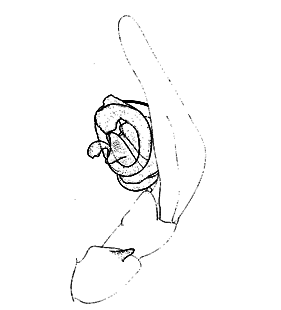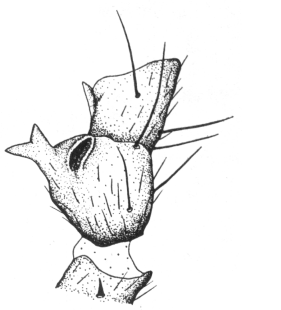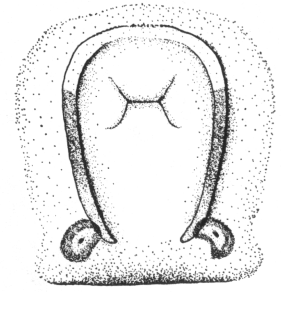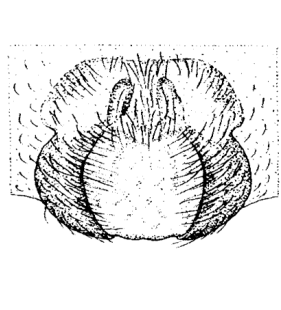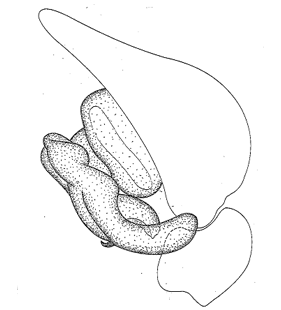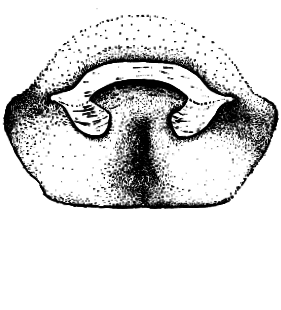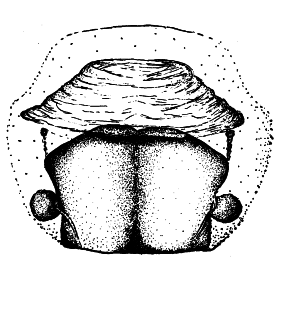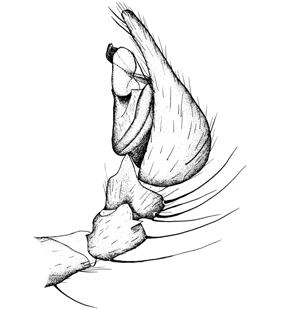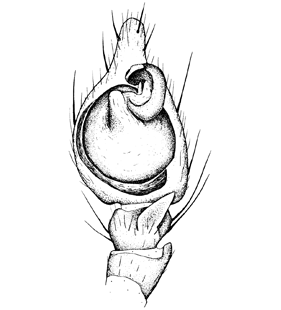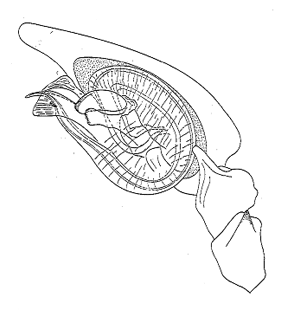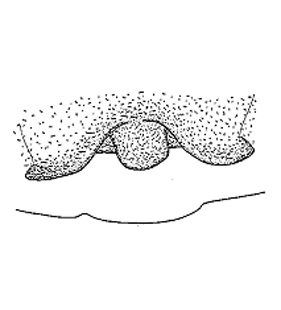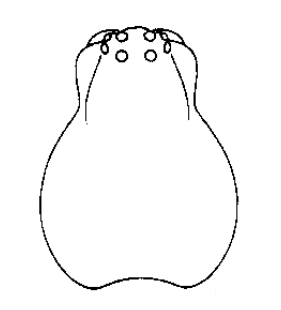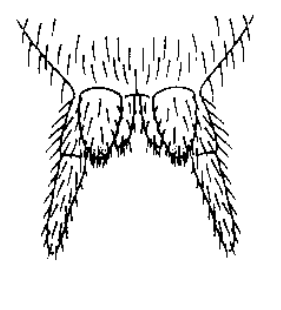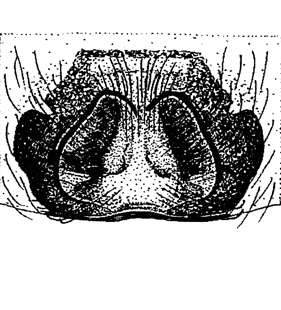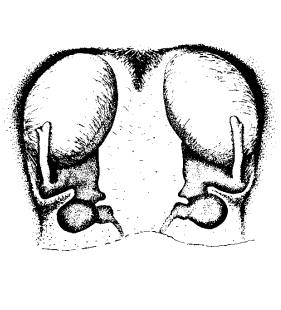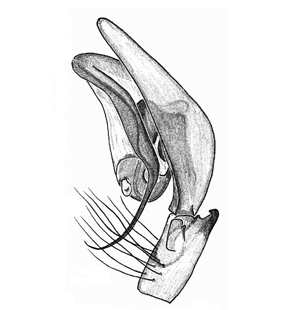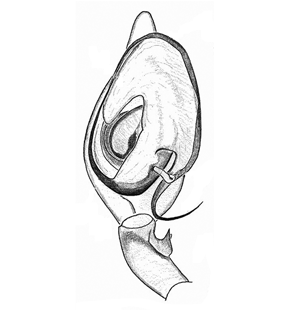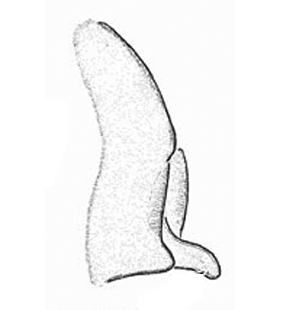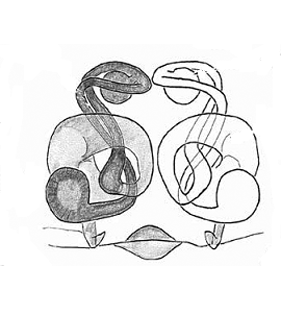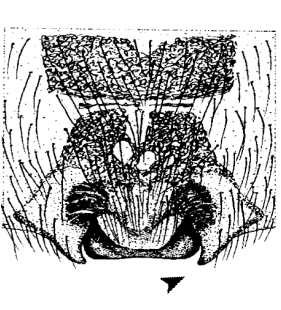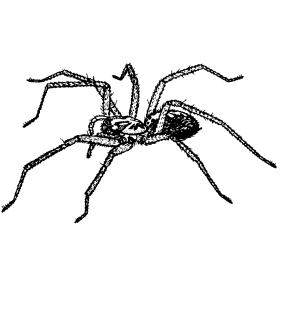Family Agelenidae C. L. Koch, 1837
|
In case you find an error or have a specific suggestion, please follow this link: click
|
||||||||
| 1 |
Prosoma in eye region not much narrower than behind, spiders with relatively stout legs, male pedipalpus with patellar apophysis (lost in Inermocoelotes), cymbium with lateral furrow, distinct epigynal teeth originating anteriorly or lateromedially of copulatory openings (in most species) |
|||||||
| - | Prosoma in eye region distinctly narrower than behind, spiders with relatively long and slender legs, male pedipalpus rarely with patellar apophysis, cymbium never with lateral furrow, if with epigynal teeth these teeth are smaller and different then described above |
|||||||
| 2 (1) |
Patellar apophysis absent, epigyne: anterior atrial margin without posterior extension |
| ||||||
| - | Patellar apophysis present, epigyne: anterior atrial margin with posterior extension |
|||||||
| 3 (2) |
Conductor strongly elongated, broad, flat, spiral with one to two apparent loops, epigynal atrium large |
| ||||||
| - | Conductor short, epigynal atrium small |
|||||||
| 4 (3) |
Patellar apophysis broad; embolus slender, epigynal teeth of normal length, copulatory ducts short |
| ||||||
| - | Patellar apophysis slender; embolus wide, epigynal teeth strongly elongated, copulatory ducts large |
| ||||||
| 5 (1) |
Trochanter III and IV notched |
|||||||
| - | All trochanter straight or only slightly curved |
|||||||
| 6 (5) |
Dorsal and lateral spines present on patellae III and IV, tarsus IV with 1–2 ventral spines |
|||||||
| - | Only dorsal spines present on all patellae |
|||||||
| 7 (6) |
Colulus developed as medially slightly divided plate, sometimes only two hairy plates visible, patellar apophysis on male palps sometimes present, median apophysis absent |
| ||||||
| - | Colulus strongly reduced, only hairs present, patellar apophysis on male palps absent, median apophysis present |
|||||||
| 8 (7) |
Eyes fully developed, tarsi with less than 7 dorsal trichobothria, cheliceral retromargin with 1 or 2 larger and several smaller teeth |
|||||||
| - | Eyes very small or lacking, tarsi with 7 or more dorsal trichobothria, several equally large teeth on the cheliceral retromargin |
|||||||
| 9 (5) |
Posterior eye row in dorsal view considerably recurved or procurved, anterior eye row in frontal view either considerably procurved or slightly recurved, patellae I and II with dorsal and prolateral spines, colulus clearly divided into two hairy plates |
|||||||
| - | Both eye rows in frontal and dorsal view more or less straight (eyes may be reduced), patellae with dorsal spines only, colulus a trapezoidal plate with the distal margin straight, w-shaped or with a notch |
|||||||
| 10 (1) |
Eye rows in dorsal view recurved, posterior median eyes largest, feathery hairs absent or conspicuously different to the hairs of Tegenaria sensu lato |
|||||||
| - | Eye rows in dorsal view procurved, posterior median eyes never largest, feathery hairs present |
|||||||
| 11 (10) |
Conductor on male palp with a conspicuous laterodorsal projection, femur of male palp with flat but distinct prominence, no patellar apophysis, epigyne with large atrium |
| ||||||
| - | Conductor on male palp without laterodorsal projection, femoral apophysis absent, patellar apophysis sometimes present, epigyne with posteriorly protruding pocket or slightly raised median portion |
|||||||
| 12 (11) |
Conductor simple, median apophysis absent, patellar apophysis absent, epigyne with posteriorly protruding pocket |
| ||||||
| - | Conductor more complex, median apophysis present, patellar apophysis present, epigyne with slightly raised median portion |
| ||||||
| 13 (10) |
Distinct spikes absent at the anal tubercle, conductor helical and strongly protruding, epigynal plate with 2 clearly divided copulatory openings |
| ||||||
| - | Anal tubercle with distinct long dark spikes, conductor differently shaped but never helical, epigynal plate longitudinally not completely divided |
|||||||
| 14 (13) |
Embolus thin and filamentous, conductor simple, anterior margin of epigynal atrium with protruding scapus |
| ||||||
| - | Embolus either broad and short or spiral elongated with an attached membrane, conductor complex, anterior margin of epigynal atrium without scapus |
|||||||
| 15 (14) |
Patellar protuberance absent, two tibia apophyses developed, embolus short and broad, vulva with an interiorly originating spermathecal head, spermathecal apophyses present |
| ||||||
| - | Patellar protuberance with a long spine, one tibial apophysis developed, embolus long and spiral with attached membrane, vulva with a laterally or medially originating spermathecal head, spermathecal apophyses absent |
| ||||||
| 16 (9) |
Extraordinary long apex/terminal end of conductor, epigyne and vulva as in figure |
|||||||
| - | Different |
|||||||
| 17 (16) |
Cheliceral retromargin with 6 or more teeth (more proximal, teeth decrease in size), retrolateral tibial apophysis with mostly two branches, lateroventral ridge absent, conductor with a membranous or massive (not very strongly sclerotised) transversal ridge, terminal end not bifid (only in E. montigena) with ventral apex forming elongated process or more complex (several points or spiral), median apophysis strongly attached to the tegulum (sometimes only membranous), distally with a simple pocket-like sclerite, vulva irregularly sclerotised (enclosed convoluted duct) and/or with diverticula attached to the copulatory duct (exception: E. sicana with two spermathecae) |
|||||||
| - | Cheliceral retromargin with 3 to 6 large, subequal teeth, retrolateral tibial apophysis mostly with three branches or strongly protruding bulge and lateroventral ridge, conductor lamelliform, sometimes with sclerotised transversal ridge, apex often bifid with ventral ending simple, median apophysis strongly protruding with distal sclerite plate-like or more complex, vulva only with convoluted duct or with more or less regularly sclerotised, globular spermathecae |
|
Further genera
- 1. Agelenopsis
- 2. Anatextrix
- 3. Gorbiscape
- 4. Hellamalthonica
- 5. Persiscape
- 6. Pseudotegenaria



